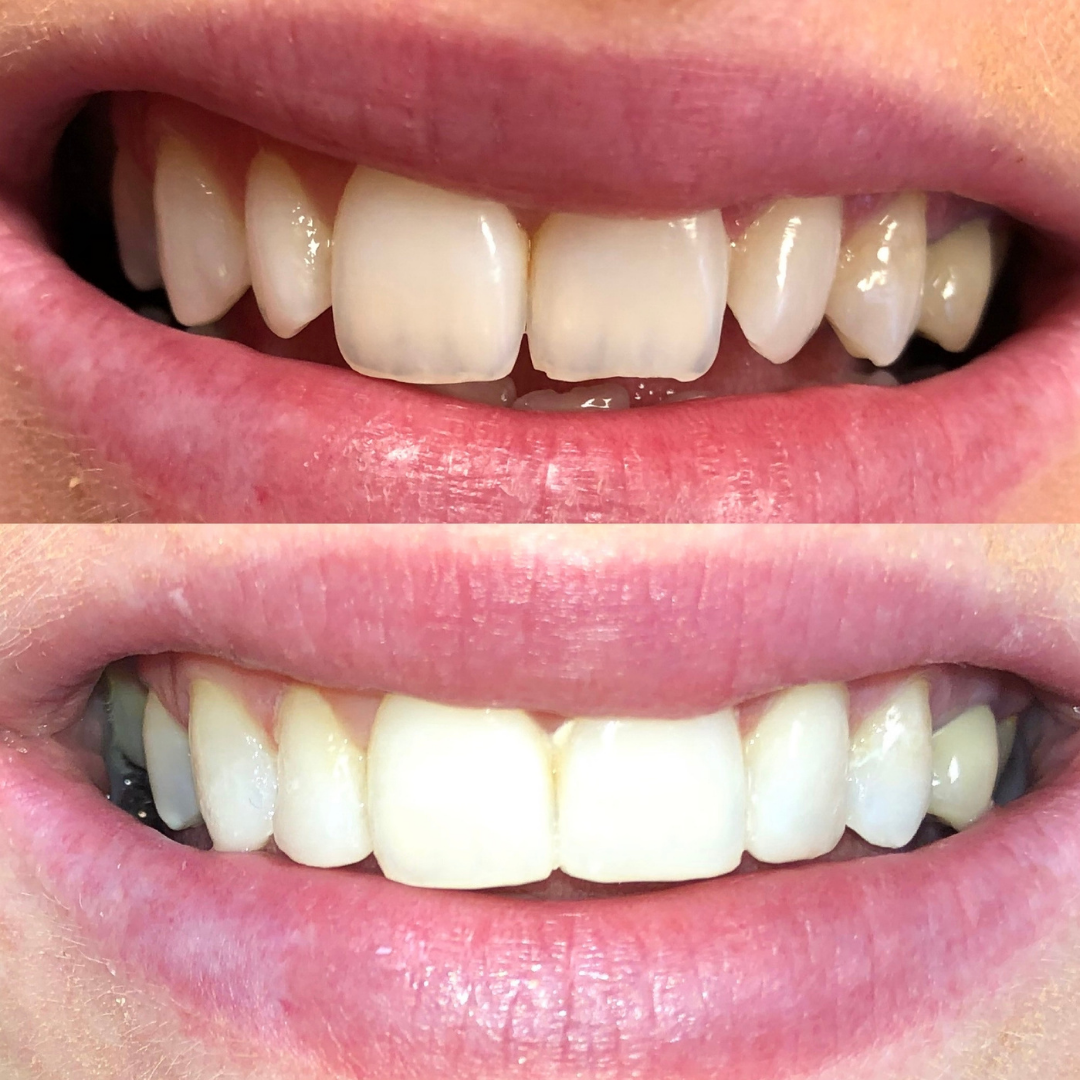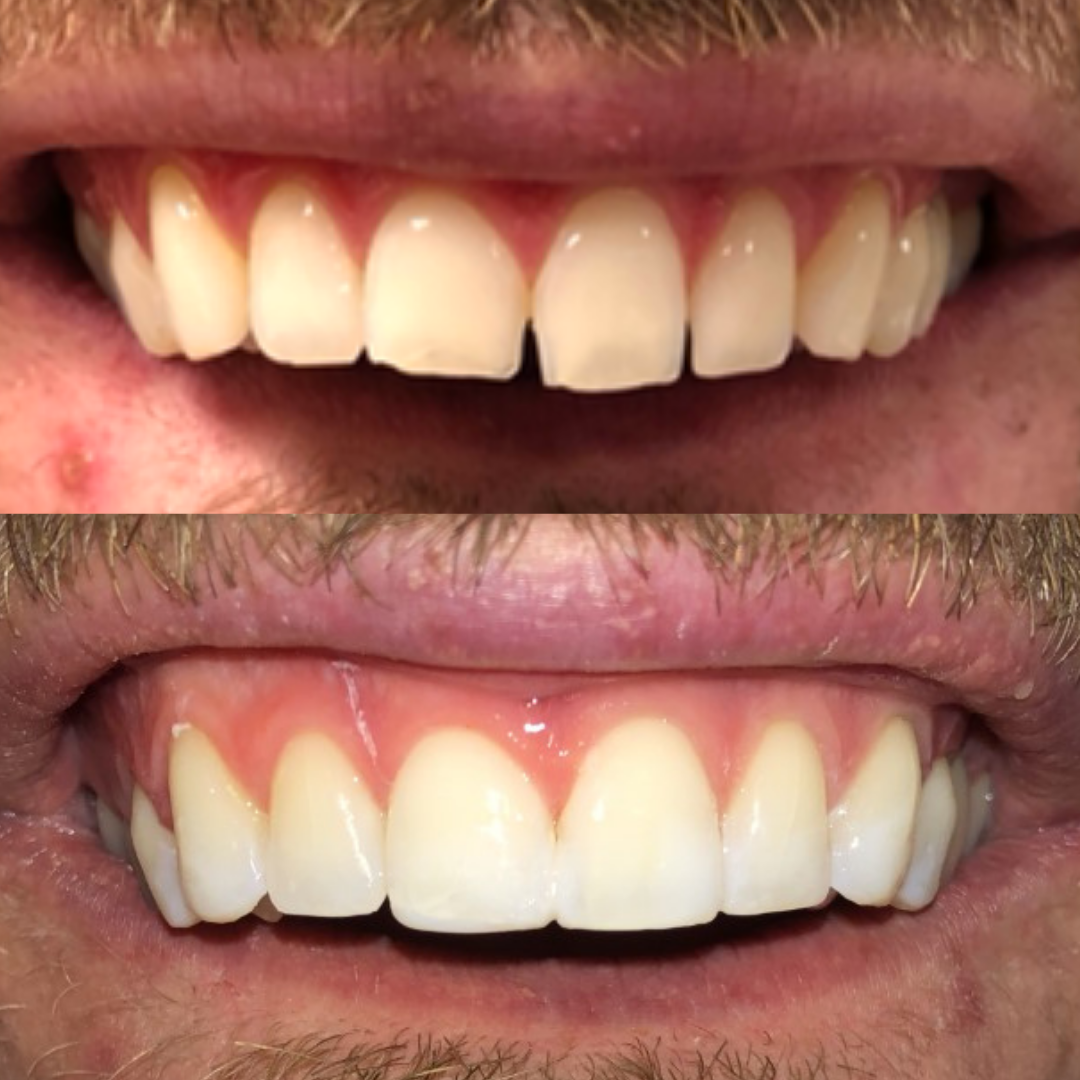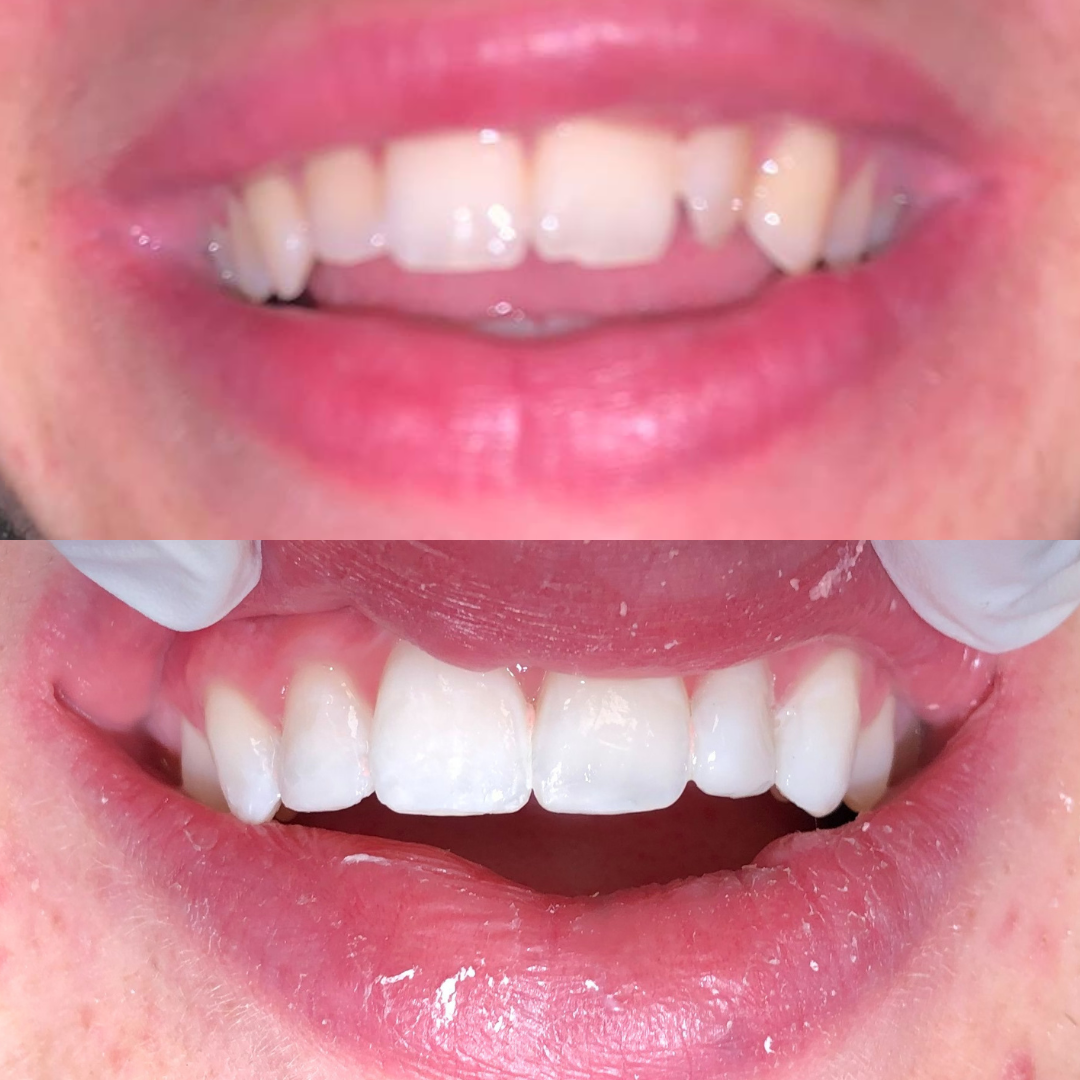Composite Veneers
Composite veneers are are minimally invasive way to a bright white smile. The difference with composite veneers when comparing them to porcelain veneers, is that they can be done with minimal to no tooth preparation, and in some cases may only require one visit. If done with no preparation to your underlying natural tooth, they are essentially a reversible treatment should you decide to have them removed later in life. A veneer is a thin shell of material, for dental purposes this means a covering over the surface of your tooth. In most instances the veneer will cover the front surface of your tooth.
The reason people choose to have dental veneers placed is usually to improve the appearance of the teeth. The nature of composite veneers means that they produce a very individual result. If you wish to select a whiter shade than your natural tooth you can do this with the help of Dr Olivia to advise you on what colours are available, and what would best suit your smile.
Composite veneers can cover up any stains on your natural tooth, change the shape or length or your teeth, create a wider smile, or disguise other dental defects. Placed expertly they will not damage the underlying tooth structure, or your gums. You are required to look after them like you would your own teeth, with regular brushing, flossing, and visits to the dental surgery!
An important fact to note is that the placement of veneers will NOT stop you from being at risk of dental decay and other dental issues, so please ensure regular dental attendance for routine screening.
Results



What Is The Composite Veneer Procedure?
When you attend Dr Olivia’s surgery, she will conduct a comprehensive assessment to check your oral health, and ascertain your suitability for the proposed treatment plan. A consultation will determine what you wish to achieve from your composite veneer treatment. Dr Olivia will assess your teeth, gums, and screen you for any dental problems. Photographs will be taken of your teeth, to be stored in your dental records, and will only be published elsewhere with your express permission.
These photographs will help with the planning process. Dr Olivia can point out any irregularities noted or minor details you may not have been aware of. They can also act as an effective tool for showcasing the before and after changes in your smile. Dr Olivia will note the natural shade of your teeth, and discuss with you your options for whitening, keeping the same shade and covering it with the composite material, or altering the shade with a brighter composite. Once a detailed assessment has been completed, Dr Olivia will write up a treatment plan based on the options you’ve been given and the treatment you have opted to go for. This may not be completed within the consultation appointment as Dr Olivia will need to look at your case in detail before determining all your options and pricing points. Once you and Dr Olivia are confident in what can be achieved and are ready to conduct the procedure (and all dental disease has been eradicated or stabilised) it will be time to get started! Preparations will be done in clinic. This will involve impressions of your teeth and other procedural considerations.
If tooth preparation is involved this will be carried out in the most minimal way possible to achieve your final look.
If tooth preparation is not required, it will be time to add the composite. There are two subcategories of composite veneers; direct and indirect. If direct composite veneers are being placed, these will be entirely performed by Dr Olivia whilst you are in the dental chair. Your teeth will be isolated with cotton wool or by another method to keep them clean and dry during the process. They will be separated from each other to avoid any dental material lodging in the interstitial spaces between the teeth. An etching gel will be applied to the tooth surface. This roughens the surface and creates an ideal surface for the bonding agent. The bonding agent is applied to close the interface between the tooth and composite resin. This creates a chemical bond between tooth and composite. The composite is then applied in incremental layers. Each layer is cured for immediate strength. The composite may be one colour, or different colours and transparencies of composite may be chosen for your desired outcome.
Once Dr Olivia is happy with the added composite, she will shape and polish the veneers. This will take time to ensure a shiny, smooth surface, and a review appointment may be required to ensure this is adequate. Any rough edges of composite will be more prone to staining. This is nothing to worry about as a simple polish will solve the issue, but this is the reason for Dr Olivia’s meticulous attention to detail. Your bite will be checked and adjusted as required. For indirect composite veneers, the results are similar but the process slightly different. Dr Olivia will do the impressions and other preparations in clinic, but the veneers will be fabricated in a dental lab. When they are back from the lab they will be trialled on your teeth to ensure Dr Olivia is happy with the fit, and you are happy with the end result. Dr Olivia will cement them onto your teeth in a similar way to the direct method of application. They will be finished and polished as above.
Who Can Benefit From Composite Veneers?
Composite veneers could be beneficial for anyone wanting to improve the appearance of their smile. It is a treatment suitable for younger or older teeth, due to its natural outcome and minimally invasive nature. If you have had issues in the past with tooth wear, composite veneers may be of benefit to you for a cosmetic improvement, but in carefully planned and executed cases it may also offer protection to your underlying tooth.
Dr Olivia is an experienced dentist with a thorough understanding of the processes of tooth wear and the implications on your occlusion (bite). The cause of your tooth wear must be determined in order to ensure you are a suitable case, and extra planning will be required to carry out the treatment effectively.
If you have gaps between your teeth or small teeth, and do not wish to undergo teeth straightening; composite veneers may be suitable to close the gaps between your teeth and give them a more aesthetic appearance.
If your teeth are discoloured, misshapen, or have defects in the surface, composite veneers are a beautiful option to rectify these concerns.
If you have healthy natural teeth, composite veneers could be an options if you wish to have a different look to your smile based on trends or personal preference. They can be placed without damage to your teeth, and so may be better than other more destructive options in such cases.
What Are The Advantages of Composite Veneers?
There are many advantages to this treatment and it is extremely versatile. One of the main advantages of this treatment over other cosmetic dental treatment makeovers is its minimally invasive nature, as it can be performed with little to no damage to your teeth. The treatment is reasonably long lasting and so you don’t have to worry about anything other than the routine maintenance of your teeth. The treatment is generally less expensive than more invasive treatments such as porcelain veneers and ceramic crowns. The treatment may be possible as a substitute to lengthy and expensive brace work. If you have a minor discrepancy in the alignment of your teeth, composite veneers can be used to mask this and make the teeth appear straighter. Composite veneers may be easier than other materials to alter them should they require a tweak. It may be possible to repair them as opposed to full replacement should they require it. Composite is a strong, durable material. This means it may protect the underlying tooth from natural wear and tear.
What Are The Disadvantages of Composite Veneers?
Disadvantages to this treatment are few and mainly due to individual interpretation. Composite veneers will not last forever (no dental treatment can). Their expectant lifespan is generally in the region of 5-10 years. In many ways this is an advantage as you may want a change in this time, and composite by nature of its make up can simply be altered/added to. Your veneers may not need full replacement. Composite material can dull or acquire stains over time. Again this is easily tweaked in order to once again achieve lustre and shine. There is a risk of the material chipping over time if you have a heavy bite or unfavourable habits.
How Long Do Composite Veneers Last?
As detailed above, the life expectancy of dental composite resin is in the region of 5-10 years. It may last less time, or much longer, depending on individual cases. To maintain your composite veneers as long as possible, you should attend for regular dental checks and hygiene visits. This way the composite can be closely monitored, polished, and touched up or tweaked as necessary.
Dr Olivia will be able to tell if any areas are prone to require intervention, before an adverse event such as a chip were to happen. Over time, the composite material may begin to dull or stain. This may mean a resurfacing is required, a simple polish, or a full treatment overhaul if you are ready for a change. Natural changes in our dentition such as minor tooth movements or mild gum recession can be categorised as reasons the treatment is passed its best, which is no fault of the procedure itself.
Can Composite Veneers Break Easily?
The composite veneers will be chemically sealed to your tooth with a strong bond. In rare cases a small piece may decement if during the cementation protocol a minor discrepancy has occurred. Dr Olivia will assess each repair on a case to case basis, but will guarantee the results for a period of time should the breakage be no fault of your own. This is at Dr Olivia’s discretion. If you are a sufferer of tooth grinding problems, you will be more likely to break away parts of the composite. Dr Olivia will likely recognise this at initial consultation, and guide you in how to minimise the risk. A bite guard may be required to protect your teeth overnight or during the day in severe cases. If the composite is very thin in parts it will be more prone to fracture. If you have had composite placed in between your teeth to close interproximal spaces, you need to ensure these areas are cleaned with floss or mini interdental brushes. You must ensure you floss the area gently to avoid extra pressure on delicate areas of composite.
What Is The Cost of Each Composite Veneer?
Composite veneers are priced according to the method of fabrication and the complexity of the case. For direct composite veneers where a lab is not required for preparatory work, the cost can start from £150 per unit. The cost is based on the style of composite veneers required, and the amount of teeth being treated may be considered in individual cases. Indirect or lab made composite veneers start from £200 per tooth. This is significantly lower than some porcelain methods, but the price may increase based on the intricacies of your case.